New Zealand had impressed us so much the first time that we decided to go back a second time already! The combination of rugged coastlines, barren volcanic regions, sparkling blue lakes and pristine national parks makes this country one of our favourite travel destinations.
In our travel blog we show you the perfect travel itinerary through New Zealand. It will take you to the greatest highlights of the country in four weeks but has many route options so that you could also easily extend it.
Inhalt

1. Travel Tips for the Preparation
Which travel guide for New Zealand?
In preparation for your travels, we would definitely recommend buying a travel guide. We have thus far tested three different travel guides for New Zealand and our favourite is the one by Lonely Planet.
You can buy the travel guide here: Lonely Planet Travel Guide New Zealand
From the south to the north or vice versa?
One very important question you should ask yourself beforehand is: Do you want to travel from the South Island and end up in the North Island or vice versa? We have been to New Zealand twice and have now tested both routes. Of course, there are pros and cons, but in our opinion, these are not huge motivators for your decision. You’ll see why soon…
Starting in the north
If you’re travelling north to south, your trip is likely to start in Auckland. The main advantage of doing it this way is that the landscapes and destinations along your road trip become more and more spectacular as you travel down south. Most of the biggest and best highlights are all waiting for you on the South Island.
Starting in the south
If you plan to start in the south, then Christchurch would make a good starting point. It’s not a secret that the most scenic destinations are all in the South Island, so the benefit of starting in the South first is that you can take as much time as you need or want at the expense of the less astounding North Island. Many people who start in the North Island tend to regret having spent too much time there and find themselves running out of time exploring the magnificent South Island.
Our recommendation
The best advice we can probably give you is to make your decisions based on cheaper flight prices. If you want to travel both islands then try book as far in advance as possible. If you only have a short amount of time left (say less than 3 weeks) then you could consider restricting your trip to just one island. If that were the case, we would choose the South Island in a heart beat!
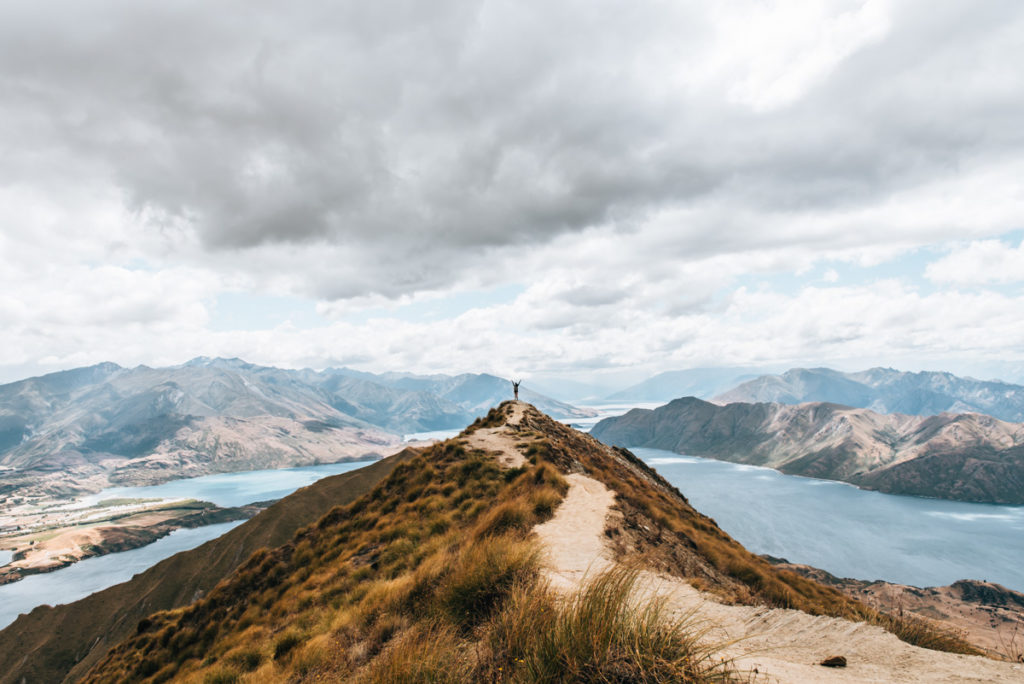
Book in advance or stay spontaneous?
A question we are often asked: “How much time in advance should I book accommodation?”. Of course, this question concerns you only if you are travelling by car and need accommodation. We will talk about the pros and cons in the next section.
We can only speak from our experiences, however, both our NZ trips turned out well as we tried to make the route as flexible as possible. We almost always booked our accommodations at most – two days in advance, often one day before or sometimes even on the day of arrival.
If you can live with this “instability and insecurity” then we can highly recommend this travel style, because only then can you:
- Respond in the most effective way to severe weather changes (the 4 seasons in one day really does exist in New Zealand!).
- Integrate the tips you pick up from locals and other passing travellers as you can often discover some really special lesser known spots.
- Go wherever you feel like. If you’re in a beach mood, head for the coast! You can skip places without feeling too guilty and decide to spend a day getting lost instead. That freedom to switch things up and discover new places is what travelling the South Island is all about!
All these possibilities escape you, if you plan your route too rigidly. The only downside, which should be mentioned, is that in the high season (Dec-Feb) you run the risk that those good bargain accommodations might be fully booked out. On several occasions, we actually had to find other alternatives, which proved to be either much more expensive or simply weren’t good value for money. In general, we managed to find some great alternatives majority of the time – despite travelling both times during peak high season.
2. Transportation in New Zealand
Of course, your journey will depend heavily on the type of transport you choose. New Zealand offers many types with the most popular modes being:
- (Rental) Car
- (Rental) Camper
- Public Bus
- Hitch-hike
Car: Flexible, but relatively cheap
For our needs the rental car was the most suitable option for both trips through New Zealand. You are always mobile and have absolutely pure freedom to decide your route. If you compare the rental price, a car is clearly cheaper than a camper and consumes way less petrol. However, you still have to add on accommodation prices, unless you decide to sleep in the car or camp outside.
If you’re staying in New Zealand for a longer time, it might be worth considering buying a car and then reselling it at the end. This is quite common, although you have to calculate that you need time to buy and sell. It can also be a little stressful if you’re not in the right place for high demand in cars. Therefore, we would advise you to only consider this option if you’re staying for more than 6 weeks.
Camper: comparatively expensive
You will find a ridiculous number of people travelling New Zealand with campers. Some are bought campers, occupied by longer term backpackers, others are rented by wealthier travellers. There is a huge variety in models and designs: from those that are no bigger than station wagons to those old vintage Volkswagens, all the way up to giant motorhomes with fancy interiors, shower and kitchen… you will find everything in between.
If you want to ‘freedom camp’, then your vehicle must be certified “self-contained”. This means that your vehicle must have certain features (including a toilet) to get the famous blue sticker. The prices for renting campers vary hugely. If you want more comfort, then you have to fork out more, as 1,000 euros per week is not uncommon in high season.
If your camper is not “self-contained”, you can only stay at campsites, for which a fee is usually payable. There are countless campsites, which all looked wonderful as far as we could tell, some were situated in the most beautiful idyllic landscapes. Nevertheless, we decided against the camper in favour of more comfort and didn’t regret it for a second.
Public bus: The cheapest option
Travelling by public bus is clearly the cheapest mode of transport (if you ignore hitchhiking). Nevertheless, the bus was never an option for us. Why? Because we wanted to be mobile, unrestricted and spontaneous. Most of the best and tucked away locations would never be reachable by public bus. With our car we were able to stop wherever and whenever we wanted, stopping and enjoying scenic highlights, taking a lunch break in the countryside or swimming in blue lakes. In short, if you do not want to compromise on this, you should definitely opt for a (rental) car or a (rental) camper.
Hitchhiking (written by Emily Peilan from Freedom Wanderers)
We hear so many horror stories hitchhiking, yet in NZ you can rest assured that is is very safe and that those horror stories account for the 0.1% of hitchhiking rates, if even that. The people who pick up hitch hikers also tend to be more open minded people and no doubt you will share some very interesting conversations. It’s a wonderful way to meet more people and learn more about different cultures, while also getting a free ride! The con is, of course, the waiting time, which can vary and depends on your luck. I’ve been picked up in 1min on a countryside road, but had to wait for 1.5 hrs once to get a ride near Christchurch.
Best tips for hitchhiking smart: max 2 people. Smile all the time and laugh when people don’t pick you up. Make sure you are standing in a visible place with your thumb out, but there must also be a pull over area behind you for the cars to stop. If you are in the middle of the highway with no where for cars to pull over, you’ll never get picked up.
Which car rental company for New Zealand?
We decided to go with Sunny Cars to manage our rental. Sunny Cars acts as a middleman or third party (ie. you book via Sunny Cars but will be forwarded more specifically to a local car rental company like Hertz. We chose Sunny Cars for two reasons. First, we found a comparatively low tariff for our period at Sunny Cars. But what was even more important to us was that Sunny Cars received a reimbursement of the deductible in the event of damage. This means that if something happens, you have to first pay the specified deductible (to the respective local car rental company), but then the deductible will be reimbursed by Sunny Cars.
Why bother to mention that? Well, we had a real incident in the South Island, where a stranger made a big scratch on our parked car while we were at the supermarket. Deductible: about 250 euros, which we had to pay to the local car rental company upfront. Fortunately, Sunny Cars refunded the amount without any question.
You can search for some cheap rental cars here: Sunny Cars
Do I need an international driver’s license?
On both of our New Zealand trips, an international driver’s license or official translation of the national driver’s license was required when renting the rental car. If possible, make sure you have an international driver’s license issued at home.
But don’t worry: on our last trip we did not have an international driver’s license. In this case, you can have an official translation of your driver’s license issued directly at the airport. The disadvantage is that the translation takes about half an hour and is much more expensive. We had to pay 70 NDZ (which converts to over 40 euros). In comparison, for you to get an international driver’s license at home, it would only cost you about 15 euros (of course, depending on your country)
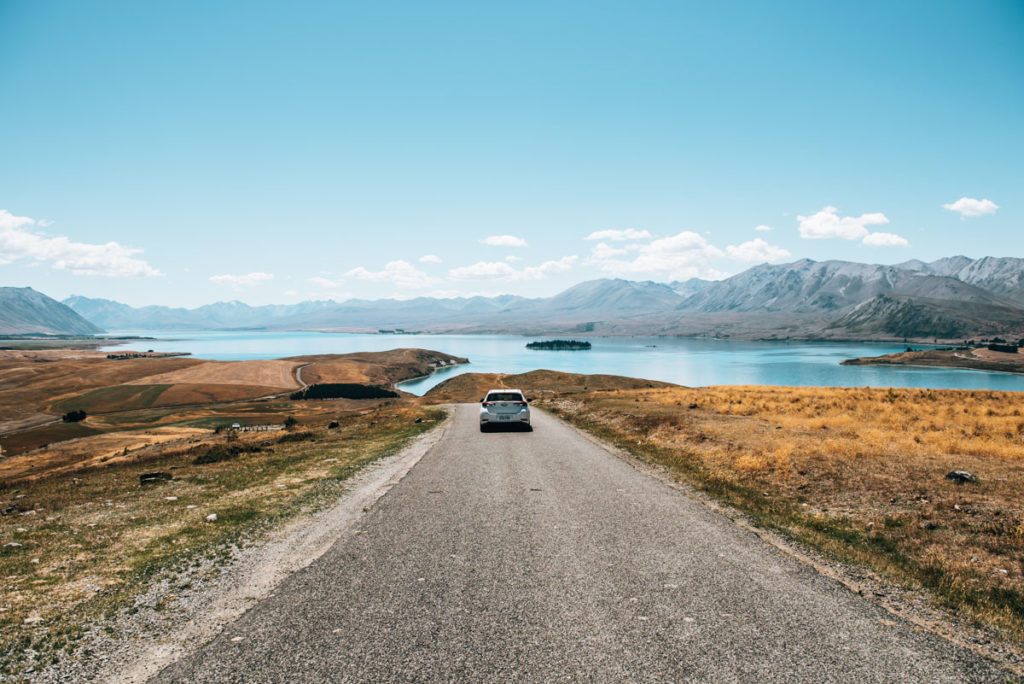
3. Traffic in New Zealand
In New Zealand, people drive on the left hand side! Don’t worry though, you’ll get used to it faster than you think. Nevertheless, you should not underestimate your adaptability as it’s easy to fall back into old habits when there’s not much oncoming traffic. Generally, we would recommend you avoid driving at night. The biggest change for us to get used to were the roundabouts, which there seems to be a lot of in New Zealand.
The advantage of New Zealand’s roads: Apart from when in larger cities, you will mostly find there is very little traffic and it’s not uncommon to pass just a few vehicles every 10km or so. It’s so nice to enjoy the scenic drives and feel like you have it all to yourself!
They call most of the main open roads ‘highways’ in New Zealand. However, this is a little misleading as to most people, these highways would be more specifically termed ‘rural roads’ and those in the south island tend to have extremely sharp winding roads. Only in a few places such as Auckland and Wellington regions, are they comparable to Europe.
However, the roads are in very good condition but not all roads are paved. There are gravel roads that you can barely get around to reach those specific destinations. These include Hokitika Gorge and Purakaunui Bay to name a couple. You can even find a paved Highway suddenly turn into a gravel road! It happened to us on the way to Lake Waikaremoana.
Note: Certain routes (such as the Ninety Mile Beach) are not allowed to be taken in the rental car for safety precautions. Make sure you look at your lease carefully, what is allowed and what is prohibited.
Important: There are plenty of petrol stations in New Zealand, but it’s not uncommon to pass dozens of kilometres before you see the next one. In sparsely populated areas we would therefore strongly recommend that you always fill up whenever you have the opportunity.
Speed limits and police checks
Outside the local area, the max speed limit in New Zealand is 100km/h. You should definitely try keep to this speed limit as much as possible because it’s very easy to get caught speeding. In addition, the penalties for driving over the limit are relatively high. As an example, we were going 17km/h too fast (117 instead of 100), we were stopped and had to pay 120 NDZ dollars (roughly 70 euros).
4. Our Itinerary in the North Island of New Zealand
We have travelled New Zealand from top to bottom and vice versa (with the pros and cons outlined in section 2 of this article). In the following two sections, we have will elaborate and pin point some of our main stops and destinations from Auckland to Christchurch.
Auckland
We started our journey in Auckland, New Zealand’s biggest city, holding more citizens than the entire South Island population combined. We recommend staying at least two or better three nights to get a nice insight into this very pretty city. We picked up the rental car on our last day in the city, before we headed north.
Our Accommodation: M Social Auckland (very modern rooms, great location next to the harbour)
Our blog article: Auckland Travel Guide
Bay of Islands / Paihia
Compared to the rest of New Zealand, the large number of people in the Bay of Islands area is surprising. Locals and tourists flock there in the summer months, as it’s great for swimming and the area is well known for dolphin watching.
Our Accommodation: Changing Tides BnB (great accomodation, highly recommended!)
Driving time: Auckland – Bay of Islands: 3 hours
Cape Reinga
Cape Reinga is the northernmost point of New Zealand and scenically quite spectacular. We visited Cape Reinga as a day trip, leaving the Bay of Islands in the morning and spending the night in Mangonui, on the way back to Auckland. The view at Cape Reinga is really breathtaking, but it takes a long time to get there. Also worth seeing is the Ninety Mile Beach, which is very close to Cape Reinga.
Driving time: Bay of Islands – Cape Reinga: 3 hours
Our blog article: From Auckland to Cape Reinga
Mangonui
Back in the only direction we can go… south. On the way back to Auckland we stayed in the small village Mangonui. The entire route from Bay of Islands – Cape Reinga – Auckland can hardly be accomplished in a day.
Our Accommodation: Acacia Lodge Mangonui (very basic rooms with kitchen, nice terrace)
Driving time: Cape Reinga – Mangonui: 2 hours
Auckland
On the way to Auckland lies the Waipoura Forest. Here you can admire New Zealand’s largest Kauri tree. In Auckland we stayed another night, the main reason being the Red Hot Chili Peppers, who were playing a concert that day. So if you don’t have such activities planned, there’s no need for another stop here.
Our Accommodation: M Social Auckland (very modern rooms, great location next to the harbour)
Driving time: Mangonui – Auckland: 4 hours
Our blog article: Auckland Travel Guide
Rotorua
In Rotorua we stayed three nights. The reason for our longer stay was in part due to our eagerness to see the Hobbiton movie set in Matamata, as well as the hot springs and geysers. If you are tight for time, then we’d say 2 nights is also enough in Rotorua to explore around. The city itself is very small and has little city buzz to offer.
Our Accommodation: Quest Rotorua (great value for money, highly recommended)
Driving time: Auckland – Rotorua: just under 3 hours
Optional: Taupo
Instead of Rotorua, you can also make a stopover in Taupo. Again, there are hot springs to admire. Taupo itself is very nice, situated by Lake Taupo, which is actually NZ’s largest lake! We liked the atmosphere much better than Rotorua.
Our Accommodation: A Loft with a View (beautiful accommodation attached to a private house, one of the favourites of our trip)
Driving time: Auckland – Taupo: just under 3.5 hours
Our blog article: Lake Taupo & Huka Falls
Ohakune / Tongariro Alpine Crossing
Ohakune is a good starting point if you dare to make the famous Tongariro Alpine Crossing, perhaps the most spectacular hike in New Zealand. We stayed for two nights to have a full day for the hike. Small warning: The hike is the most popular hike in NZ and in high season, it feels like a mass migration of small humans. However, despite this, we would still say that it’s worth it because the landscape is so spectacular and unique.
Our Accommodation: Station Lodge Ohakune (classic hostel with bunk beds, unfortunately no heating, helpful and friendly owner)
Driving time: Rotorua – Ohakune: approx. 2 hours and 45 minutes
Wellington
New Zealand’s capital Wellington has a reputation for being the country’s windiest city and we can certainly confirm that. But despite that, we really liked this very pretty harbour city. On our last trip we stayed two nights, but even if we had stayed three nights, we would not have been bored as there’s plenty to do and see.
Our Accommodation: Novotel Wellington (very central, comfortable rooms, good value for money)
Driving time: Ohakune – Wellington: 3.5 hours
Our blog article: Tips for Wellington
5. Our Itinerary on the South Island of New Zealand
Nelson
With the Inter Islander ferry, we went from Wellington to Picton, where we received our rental car for the South Island. Due to the high costs associated with bringing rental cars across the strait via ferry, it just makes more financial sense to rent separate cars for each island. We stayed for three nights in Nelson, a pretty little town with a very nice environment. We used Nelson as the base for our day trip to the Abel Tasman National Park. But there is much to discover in Nelson and its Marlborough region, including an abundance of wineries.
Our Accommodation: Quest Nelson (great value, reminiscent of an apartment – there is even a washing machine)
Driving time: Picton – Nelson: just under 2 hours
Our blog article: Our day hike in the Abel Tasman National Park
Fox Glacier / Franz Josef Glacier
The route from Nelson to the two famous glaciers, the Fox and the Franz Josef Glacier, was one of the longest drives on our entire road trip through New Zealand. Here you will pass very sparsely populated areas and very little traffic. A nice worthwhile stopover would be at the Pancake Rocks, a spectacular natural rock formation viewable from the roads!
While we had to give up the option of the very expensive glacier tours in Fox and Franz Josef Glacier, we embarked on our own little adventure instead along the free hiking trails, which we can highly recommend. Especially noteworthy is the one-hour circular walk around Lake Matheson, where you can see a perfect reflection of Mount Cook in good weather.
Our Accommodation: Bella Vista Hotel Fox Glacier (centrally located, small rooms, barbecue in the garden)
Driving time: Nelson – Fox Glacier: 6.5 hours
Optional: Wanaka
You can in fact drive directly to Queenstown from the West Coast – that’s how we did it on our first trip. If you are not too tight for time, we would definitely recommend a stopover in Wanaka. The route from the glaciers to Wanaka and on to Queenstown is one of the greatest scenic spots we have seen in all of New Zealand. We often stopped in between to admire the crystal blue lakes and rivers. If you do not mind ice-cold water, then stop by the Blue Pools near the small town of Makarora.
Wanaka itself is beautifully located right by Lake Wanaka. Here we felt comfortable from the first moment. We were incredibly lucky with the weather and could swim several times in Lake Wanaka. One of New Zealand’s most spectacular day hikes is also here: the trek to Roys Peak.
Our Accommodation: Wanaka Alpine Lodge (beautiful rooms, very comfortable, priced above average)
Driving time: Fox Glacier – Wanaka: 3 hours 15 minutes
Our Blog Article: Walk on the Roys Peak & Travel Tips for Wanaka
Queenstown
From Wanaka, it is best to drive via Crown Range Road (Cardrona) to Queenstown. You can also make a stop in the small village of Arrowtown.
Queenstown was and still remains one of our favourite places in NZ. Here you will come across a lot of young people and probably for the first time in a long time feel that there is something happening in the South Island! Queenstown is incredibly spectacular, located on Lake Wakatipu. If you’re fit, you should adventure up the one-hour walk to Bob’s Peak, from where you have an absolutely stunning panoramic view of Queenstown. Alternatively, you can take the easy route via cable car.
Our most adventurous experience was undoubtedly our helicopter ride over Queenstown. Our hearts still skip a beat when we think about it.
Our Accommodation: Amity Lodge Motel (relatively central, basic rooms, very good value for money)
Travel time: Wanaka – Queenstown: 1 hour
Our blog article: By helicopter over Queenstown & our travel tips
Te Anau
We used Te Anau as a base to visit to Milford Sound in the Fiordlands. To have a full day at Milford Sound, we stayed 2 nights. Retrospectively, even these two days were too long, because Te Anau itself has absolutely nothing to offer. The mood is kind of strange, especially if you come from the lively Queenstown. We would come back to this area, but probably choose another place to stay.
Our Accommodation: Radfords on the Lake (Modern hotel right on the lake, highly recommended)
Milford Sound
Milford Sound is a spectacular fjord that you can visit as part of a boat trip. We made our way to Milford Sound as a day trip from Te Anau. You can easily drive directly to the car park of the Cruise operators. We chose the Southern Discoveries boat tour, which we highly recommend.
Here you can book the tour in advance: Milford Sound Boat Tour
Driving time: Te Anau – Milford Sound: 1 hour 45 minutes (may take longer in winter with snow)
Owaka / The Catlins
The Catlins is a very rugged, sparsely populated region in the southeast of the island. Not many tourists tend to wander here and this genuine authenticity is what makes the area so attractive. The landscape is huge and you can see seals and penguins and sometime even dolphins at Curio Bay. A particularly famous photo opportunity here is at Nugget Point.
Our Accommodation: Catlins Area Motel (spacious motel with very good value for money)
Driving time: Te Anau – Owaka: 2 hours 45 minutes
Our blog article: The Catlins – New Zealand’s rough coastal landscape
Dunedin & Otago Peninsula
The Scottish founded town of Dunedin is definitely worth a stopover. From here you can explore the stunning Otago Peninsula. We would recommended visiting Sandfly Bay, a deserted beach where you can observe seals from very close proximity. We also found Tunnel Beach to be very impressive.
Our accommodation: Aria on Bank (very nice two-storey apartments, a bit expensive)
Travel time: Owaka – Dunedin: 1 hour 20 minutes
Our blog article: Dunedin & Otago Peninsula
Lake Tekapo / Mount Cook
One of our favourite places in the South Island is Tekapo, situated on the sparkling blue lake of Lake Tekapo. Here, above all, the focus is on nature. We used Tekapo as a base for a hike through Mount Cook National Park. The Hooker Valley track is highly recommended, roughly 3hrs of impressive views and bridges. The track is suitable for non-hikers too.
Our Accommodation: Starview 88 Apartment (great, modern apartment, unfortunately quite expensive)
Driving time: Dunedin – Lake Tekapo: 3.5 hours
Our blog article: Tips for Lake Tekapo
Christchurch
The final destination on our New Zealand itinerary was Christchurch, still visibly affected by the 2011 earthquake. A lot has changed compared to our last stay in 2013. There are some very cool cafés back in town. The Christchurch Gondola ride to Mount Cavendish is very worthwhile.
Our Accommodation: Golden Hotel (modern aparthotel with great value for money)
Driving time: Lake Tekapo – Christchurch: 3 hours
Our blog article: Christchurch – Tips & Attractions
6. More New Zealand Travel Reports
Disclaimer: Affiliate Links
This blog article contains our personal recommendations in the form of so-called affiliate links. If you book or buy something via the links, we will get a small commission. For you, this does not change the price. How great is that? For our rental car in New Zealand, we did receive a discount from Sunny Cars – which we have to thank for! We have booked several times via Sunny Cars (at full price) and always had good experiences.
Do you have any other tips for the perfect itinerary through New Zealand? We look forward to hearing your comments!
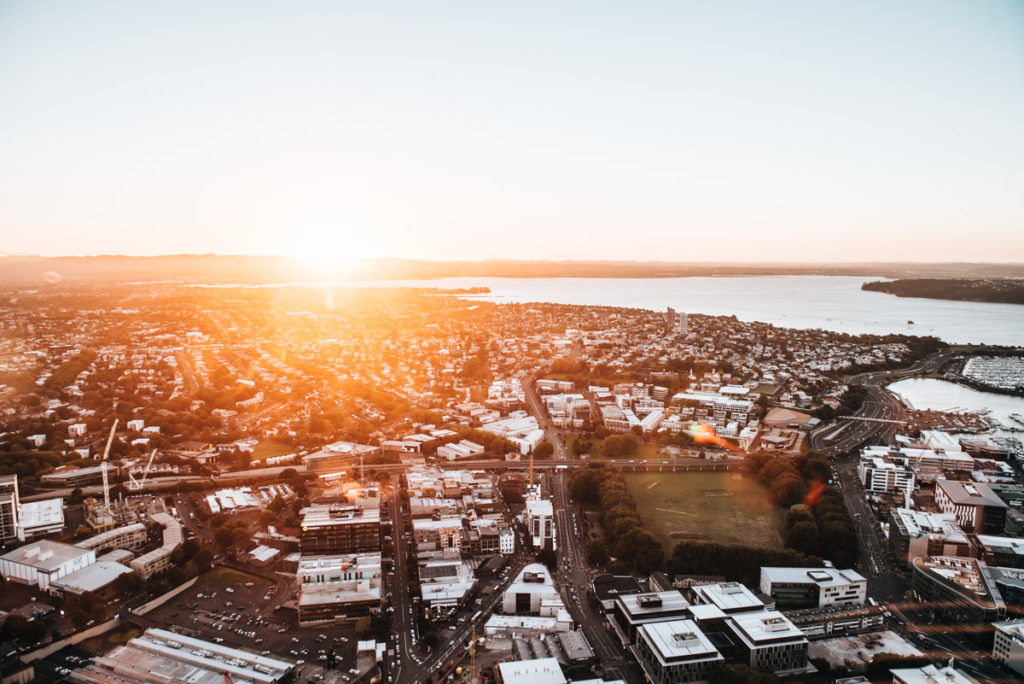
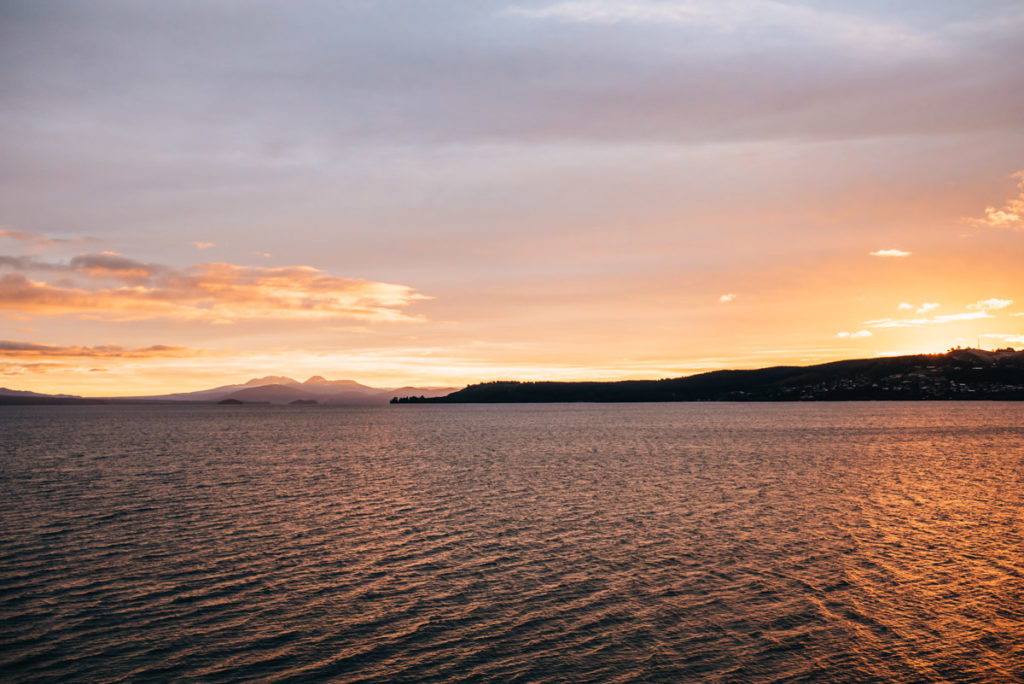
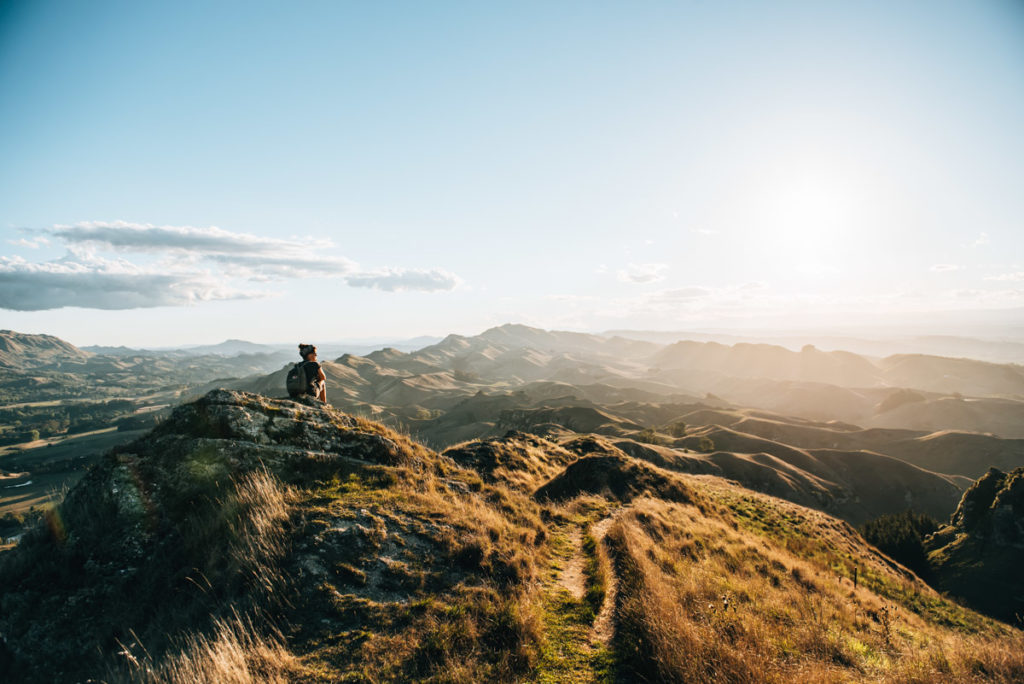
Thanks for sharing these tips with the world… We are just starting to plan a trip to NZ and want to stay about 4 weeks. What would be your advice in terms of month(s) to go?
Next February is probably a bit of short in terms of planning?
Would you recommend starting mid November and leaving well before Christmas?
Hi Erik,
thanks! February sounds good to us. We’re very spontaneous – we booked our flight to New Zealand about two weeks ahead of the trip. ;)
However, mid November until Christmas would be fine too.
Safe travels,
Kathi & Romeo
Hi guys, first up amazing reviews, very well communicated, they really helped me, the pics are not bad either ;)
Would you be able to spare a few moment to look over the below schedule, over 29 nights in NZ, which take in a few nights at the beginning in Auckland and at the end which are fixed to be with our friends who live over there. We’ll be flying in from the EU. Any advice, even just a basic that looks like a well balanced trip, will be great :)
Auckland 3 nights, Coromandel Peninsula 3 nights, Lake Taupo 1 night, Napier 2 nights, Wellington 2 nights, Ferry to South island Abel Tasman 4 nights, Franz Joseph 1 night, Queenstown 3 nights, Dunedin 1 night, Lake Takapo 2 nights, then fly back to Auckland, Waiheke island 2 nights followed by a few days back in Auckland before departing.
Hi Tom,
looks good. We personally woulnd’t spend 4 nights in Abeld Tasman but you’re probably planning to hike along the Coast? If you are spending a few days in Auckland at the end of the trip you could think of cutting down your time at the beginning. Are you planning to visit Tongariro? We would recommend you to put this area on your list.
Safe travels,
Kathi & Romeo
Kathi/Romeo
Many thanks for taking the time to reply, and for the advice. Will look into the Tongariro area and had kinda come round to thinking of reducing Abel Tasman to 3 nights and scrubbing the 2nd visit to Auckland with a few nights in Russell BOI. At present no firm plans for Abel, would you suggest trying to work Tongariro in instead then?